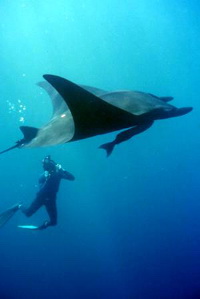Manta ray
From Wikipedia, the free encyclopedia
[Photo] Giant Pacific Manta. A large symbiotic remora is visible on the manta's ventral side. Image created by David McMurdie, from a photo taken by David McMurdie, near San Bendicto Island, Mexico, Spring, 2003.
The manta ray, or giant manta (Manta birostris), is the largest of the rays, with the largest known specimen having been nearly 7.6 meters (25 ft) across its pectoral fins (or "wings") and weighed in at 3,000 kg (6,600 lb). It ranges throughout the tropical seas of the world, typically around coral reefs. Mantas are most commonly black above and white below, but some are blue on their backs. A giant manta's eyes are located at the base of the cephalic lobes on each side of the head, and unlike other rays the mouth is found at the anterior edge of its head. To breathe, like other rays, the manta has five pairs of gills on the underside. The manta ray's mouth is big enough to fit 4 full grown men through it at once.
With distinctive "horns" (from which the common name 'devil ray' stems), on either side of its broad head, the manta is a prized sighting by divers. These unique structures are actually derived from the pectoral fins. During embryonic development, part of the pectoral fin breaks away and moves forward, surrounding the mouth. This gives the Manta Ray the distinction of being the only jawed vertebrate to have novel limbs (the so-called six-footed tortoise (Manouria emys) does not actually have six legs, only enlarged tuberculate scales on their thighs that look superficially like an extra pair of hind limbs). These flexible horns are used to direct plankton, small fish and water into the Manta's very broad and wide mouth. The manta can curl them up to reduce drag while swimming.
Manta Rays may have evolved from bottom feeding ancestors but have adapted to become filter feeders in the open ocean. This has allowed them to grow to a larger size than any other species of ray. Because of their pelagic lifestyle as plankton feeders, some of the ancestral characterstics have degenerated. For example, all that is left of their oral teeth is a small band of vestigial teeth on the lower jaw, almost hidden by the skin. Their dermal denticals are also greatly reduced in number and size, but are still present, and they have a much thicker body mucus coating than other rays. Their spiracles have become small and non-functional, as all water is taken in through their mouth instead.
To swim better through the ocean, they have a diamond shaped body plan, using their pectoral fins as graceful "wings".
Mantas are filter feeders: they feed on plankton, fish larvae and the like, passively filtered from the water passing through their gills as they swim. The small prey organisms are caught on flat horizontal plates of russet-coloured spongy tissue, that span the spaces between the manta's gill bars.
Mantas frequent reef-side cleaning stations where small fish such as wrasses and angelfish swim inside the manta's gills and all over its skin to feed, in the process cleaning it of parasites and removing bits of dead skin.
The predators of the Manta Ray include mainly large sharks, however in some circumstances killer whales have also been observed preying on them.
Taxonomically, the situation of the mantas is still under investigation. Three species have been identified: Manta birostris, Manta ehrenbergii, and Manta raya, but they are quite similar to each other, and the last two may just be isolated populations. The genus Manta is sometimes placed in its own family, Mobulidae, but this article follows FishBase, and places it in the family Myliobatidae, with the eagle rays and their relatives.
Mantas have been given a variety of common names, including Atlantic manta, Pacific manta, devil ray, devilfish, and just manta. Some people just call all members of the family stingrays.
Mantas are extremely curious around humans, and are fond of swimming with scuba divers. They have the biggest brains of any fish.
The Moche people of ancient Peru worshipped the sea and its animals. They often depicted manta rays in their art.
http://en.wikipedia.org/wiki/Manta_ray
| The text in this page is based on the copyrighted Wikipedia article shown in above URL. It is used under the GNU Free Documentation License. You may redistribute it, verbatim or modified, providing that you comply with the terms of the GFDL. |
|

